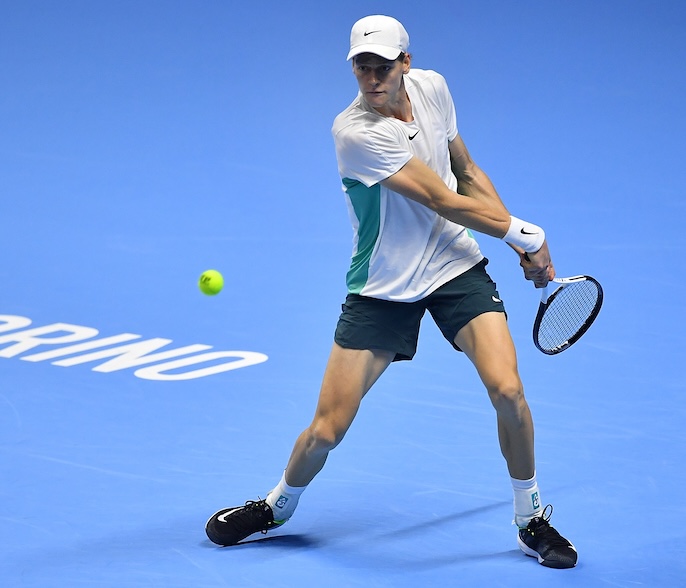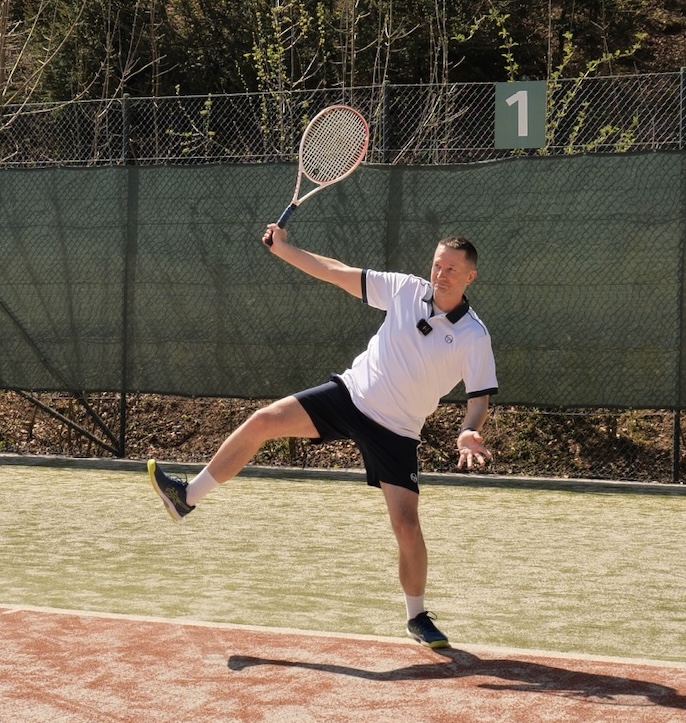The one-handed backhand stroke technique is much more natural when we step into the ball but there are quite a few situations in tennis where that's just not possible and we have to resort to an open stance.
So, let’s break it down and look at how the open stance works with the one-handed backhand— and how it’s different from the forehand and two-handed backhand when played in an open stance.One-Handed vs Two-Handed Backhand vs Forehand in Open Stance
Of all three types of groundstrokes, the forehand is the most comfortable in open stance.
That’s because the arms can swing freely, generating a lot of angular momentum— and that’s what makes it easy to produce power.

Open stance forehand gives you very easy power contrary to what you are constantly being told online.
The next in line when it comes to comfort and easy power in open stance is the two-handed backhand.
It is a much more rotational stroke than the one-handed backhand and since an open stance position encourages a lot of body rotation, we can hit the two-handed backhand also quite well in open stance.
In fact, Serena and Venus Williams were taught from early age to play most of their two-handed backhands in open stance and they dominated the women's tennis at the peak of their careers.

Serena Williams played most of two-handed backhands in open stance even if she had time to step in but chose not to...
Every pro, whether on ATP or WTA tour is now very skilled at playing two-handed backhands in open stance as they need to play them often since the game is so fast.

Jannik Sinner is another player that uses the two-handed backhand in open stance a lot.
But there's something unique about the one-handed backhand's technique - it does not allow as much body rotation as the forehand and the two-handed backhand strokes do.
Therefore the open stance position when hitting a one-handed backhand is much more uncomfortable and it does not give you easy power.

Surely you don't want to end up in this position on your one-handed backhand, do you? 😉
If you do attempt to rotate through like with the forehand or two-handed backhand, then you will likely lose control of your shot as well as losing balance which will cause much longer recovery time for the next shot.
So can you make the best of the one-handed backhand in open stance?
Two Keys to Controlled One-Handed Backhands in Open Stance
Your tactical goal when hitting one-handed backhands in open stance is not maximum power because you are almost certainly in a tough situation; otherwise you would have stepped into a neutral stance.
Therefore your goal is good control of the backhand stroke so that you can hit a quality neutralizing shot and prevent your opponent from pressuring you again.
Key 1: Load the Outside Leg
What does this mean? It means that your main source of power isn’t your shoulder rotation—it’s your outside leg and hip drive.
If you are right-handed, you’ll need to coil into your left leg, stay grounded, and push hard upward and forward.

Unless you are completely out of time, do your best to load the outside leg well so that you can then drive up to generate power.
This will allow you to gain the power to have a cleaner and better shot since you are not rotating your body as much.
But, if you keep your outside leg straight, you lose your strength and domination of your body because then you are just standing straight and you have no push power when you hit.
The shot will come off weak and you will feel disconnected from your body.
Key 2: Stop the Rotation
It’s tempting to let your body turn and rotate when taking the shot, but with the one-hander, that over-rotation leads to errors.
You must stay sideways yet still be open at a 45-degree angle. This is the right position to be able to move your arm and your racket along the proper swing path while you stay in control of your shots.

Control the amount of rotation in order to hit the ball cleanly as that will give you enough power.
To control the ball, you need to limit upper body rotations, but you can always let your body rotate and shake it off after contact during recovery.
When To Use Open Stance With One-Handed Backhands?
Let’s be clear: this is not your go-to shot.
The open stance with the one-handed backhand is a tool that is used only when you have to.
You don’t use it when you want to, only if the situation calls for its use. This tool does not hit winners but gets you out of difficult situations.
There are two common scenarios that happen:
1. Defensive Baseline Situations
Let’s say you are in a situation where you’re pulled wide or you don’t have time to set up properly. In this case, stepping in simply isn’t an option.
In that case, "stay open", load your outside leg, then drive upwards and focus on controlling your body rotation while looking to hit the ball clean and aiming deep with a good height above the net.
If you really don't have time to load the leg than focus on good stability of the outside foot as that will also serve as the source of enough power to hit the ball deep if you time it well.

I barely got to this ball so I focused on being really stable on my outside foot.
Your goal is not to hit back an offensive shot but a neutralizing one. After that quickly recover and look for ways of turning neutralizing rallies into offense.
2. Return of First Serves
To return a fast first serve, you certainly don’t want to add more speed by stepping into the ball and whacking it hard. Your objective is control of the ball and neutralizing your opponent.
The open stance one-handed backhand is again the right solution; the only difference here is that you can have a bit more forward momentum generated with movement prior to the split step, as that helps you control a fast incoming ball even better.

Practice loading the outside leg and playing returns of first serves in open stance.
Final Thoughts
The key to playing tennis well is not to have any weaknesses; that applies to technique as well as to tactics.
The one-handed backhand in open stance is a very useful solution to have in your technical toolbox so that you can use it well when a challenging situation arises.
It is a very tricky shot and requires much more body and balance control than the forehand or the two-handed backhand.

Oh, and don't forget to really watch the ball well!
So next time you feel rushed or pulled wide, don’t panic.
Stay open. Load the leg. Control the swing path and the body rotation.
Let me know in the comments below how this worked for you!




